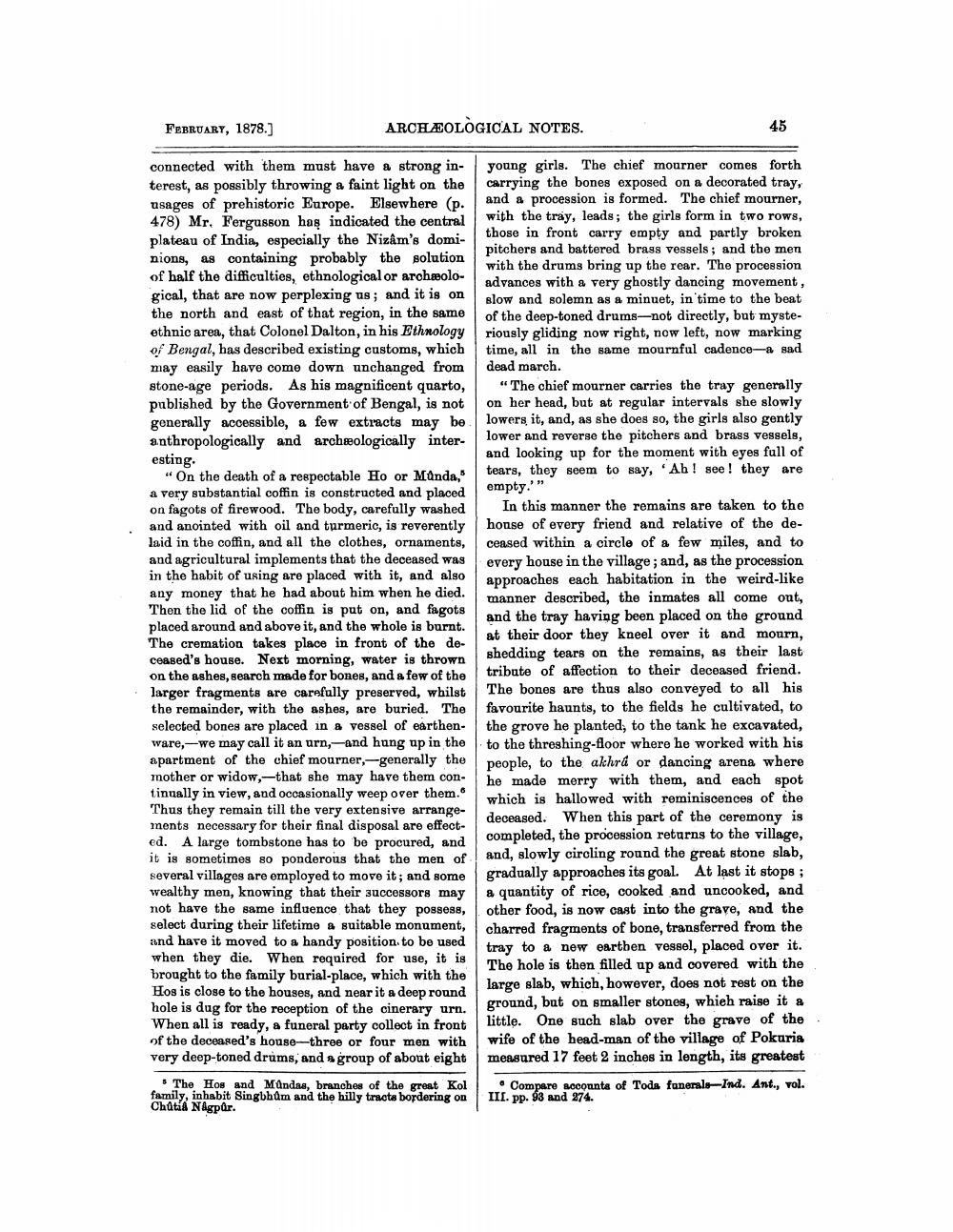________________
ARCHEOLOGICAL NOTES.
FEBRUARY, 1878.]
connected with them must have a strong interest, as possibly throwing a faint light on the usages of prehistoric Europe. Elsewhere (p. 478) Mr. Fergusson has indicated the central plateau of India, especially the Nizâm's dominions, as containing probably the solution of half the difficulties, ethnological or archæological, that are now perplexing us; and it is on the north and east of that region, in the same ethnic area, that Colonel Dalton, in his Ethnology of Bengal, has described existing customs, which may easily have come down unchanged from stone-age periods. As his magnificent quarto, published by the Government of Bengal, is not generally accessible, a few extracts may be anthropologically and archeologically interesting.
"On the death of a respectable Ho or Munda," a very substantial coffin is constructed and placed on fagots of firewood. The body, carefully washed and anointed with oil and turmeric, is reverently laid in the coffin, and all the clothes, ornaments, and agricultural implements that the deceased was in the habit of using are placed with it, and also any money that he had about him when he died. Then the lid of the coffin is put on, and fagots placed around and above it, and the whole is burnt. The cremation takes place in front of the de
ceased's house. Next morning, water is thrown on the ashes, search made for bones, and a few of the larger fragments are carefully preserved, whilst the remainder, with the ashes, are buried. The selected bones are placed in a vessel of earthenware, we may call it an urn, and hung up in the apartment of the chief mourner,-generally the mother or widow,-that she may have them continually in view, and occasionally weep over them." Thus they remain till the very extensive arrangements necessary for their final disposal are effected. A large tombstone has to be procured, and it is sometimes so ponderous that the men of several villages are employed to move it; and some wealthy men, knowing that their successors may not have the same influence that they possess, select during their lifetime a suitable monument, and have it moved to a handy position. to be used when they die. When required for use, it is brought to the family burial-place, which with the Hos is close to the houses, and near it a deep round hole is dug for the reception of the cinerary urn. When all is ready, a funeral party collect in front of the deceased's house-three or four men with very deep-toned drums, and a group of about eight
The Hos and Mundas, branches of the great Kol family, inhabit Singbhum and the hilly tracts bordering on Châtia Nagpur.
45
young girls. The chief mourner comes forth carrying the bones exposed on a decorated tray, and a procession is formed. The chief mourner, with the tray, leads; the girls form in two rows, those in front carry empty and partly broken pitchers and battered brass vessels; and the men with the drums bring up the rear. The procession advances with a very ghostly dancing movement, slow and solemn as a minuet, in time to the beat of the deep-toned drums-not directly, but mysteriously gliding now right, now left, now marking time, all in the same mournful cadence-a sad dead march.
"The chief mourner carries the tray generally on her head, but at regular intervals she slowly lowers it, and, as she does so, the girls also gently lower and reverse the pitchers and brass vessels, and looking up for the moment with eyes full of tears, they seem to say, 'Ah! see! they are empty."
In this manner the remains are taken to the honse of every friend and relative of the deceased within a circle of a few miles, and to every house in the village; and, as the procession approaches each habitation in the weird-like manner described, the inmates all come out, and the tray having been placed on the ground at their door they kneel over it and mourn, shedding tears on the remains, as their last tribute of affection to their deceased friend. The bones are thus also conveyed to all his favourite haunts, to the fields he cultivated, to the grove he planted, to the tank he excavated, to the threshing-floor where he worked with his people, to the akhra or dancing arena where he made merry with them, and each spot which is hallowed with reminiscences of the deceased. When this part of the ceremony is completed, the procession returns to the village, and, slowly circling round the great stone slab, gradually approaches its goal. At last it stops; a quantity of rice, cooked and uncooked, and other food, is now cast into the grave, and the charred fragments of bone, transferred from the tray to a new earthen vessel, placed over it. The hole is then filled up and covered with the large slab, which, however, does not rest on the ground, but on smaller stones, which raise it a little. One such slab over the grave of the wife of the head-man of the village of Pokuria measured 17 feet 2 inches in length, its greatest
Compare accounts of Toda funerals-Ind. Ant., vol. III. pp. 93 and 274.




